Easier cycling using electricity, part 4
Peter van der Linden
Where we are now
This is where we are so far. The new tires are on the wheels, the wheels and motor are on the bike, and everything has been adjusted correctly. The final step is to add the control electronics.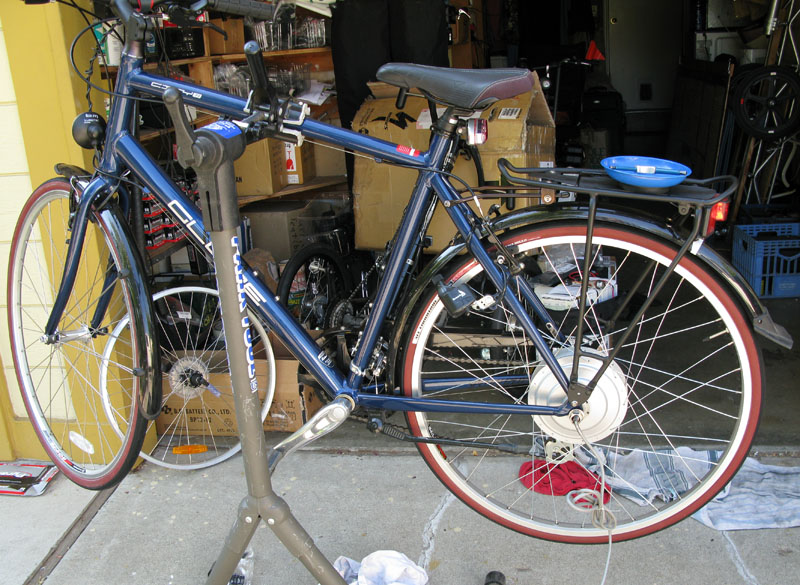
Here's how the bike looks at this point in the build
These are the remaining components we need to fit.
- controller unit
- battery pack
- throttle
- battery charger
Controller
The controller is a slim aluminum box, about the size of a packet of cigarettes. It reads the throttle setting, and feeds a proportionate amount of battery power to the motor.The controller contains circuits that detect overheating in the motor, and cut power to it. It also prevents the battery being discharged below a certain voltage, which damages lithium-ion cells. It should be mounted where a cooling airflow passes over it.
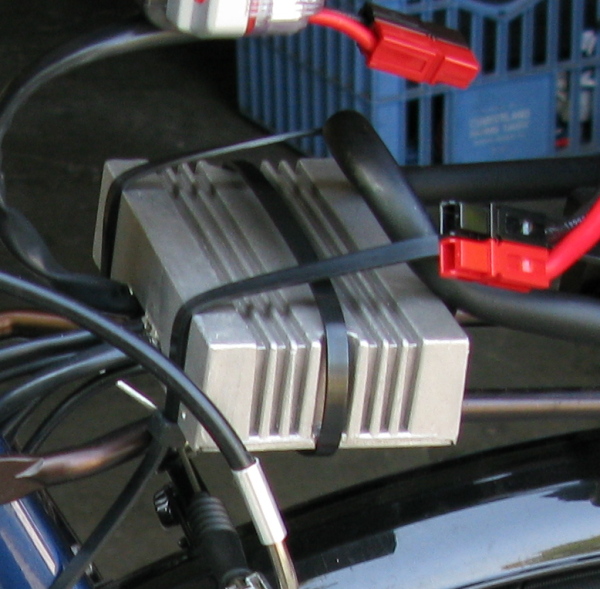
The controller is tie-wired to the rack beneath the saddle.
Battery pack
There are three battery technologies in current use.- Sealed Lead-Acid (SLA) cheap, heavy, no memory effect, quick loss of charge when not in use, 300 charge cycle lifetime. Their only advantage is they're the least expensive to replace.
- Nickel-Metal Hydride (NiMH) medium price, medium weight, no memory effect, medium loss of charge when not in use, 500 charge cycle lifetime.
- Lithium Ion Polymer (LiPo) pricey, light, no memory effect, slow loss of charge when not used, 1000 charge cycle lifetime.
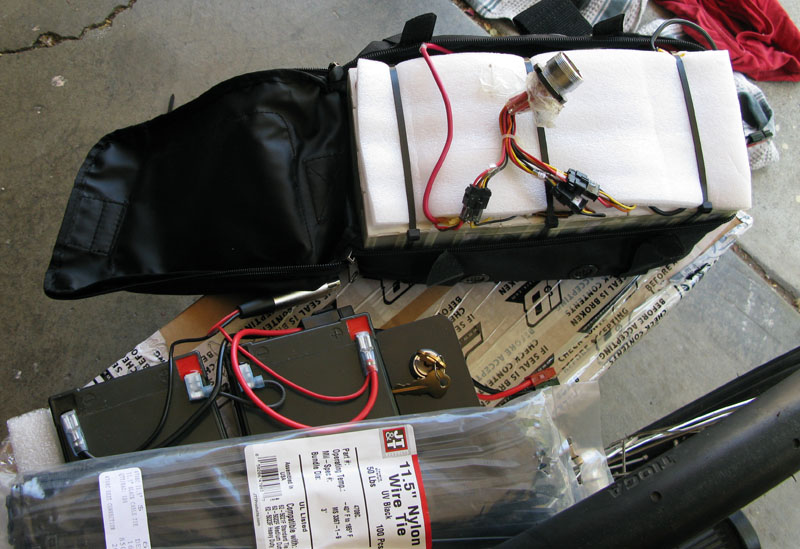
Tie wrap some insulating foam across the top of the cells.
If optimizing for performance, get LiPo batteries. If you're building to a budget, NiMH batteries are a good compromise.
The switch-off circuits that have to be present on lithium-ion batteries (to protect the cells when the voltage drops below a certain level) can unexpectedly leave you without power. NiMH cells will continue to provide some power at a lower voltage level.
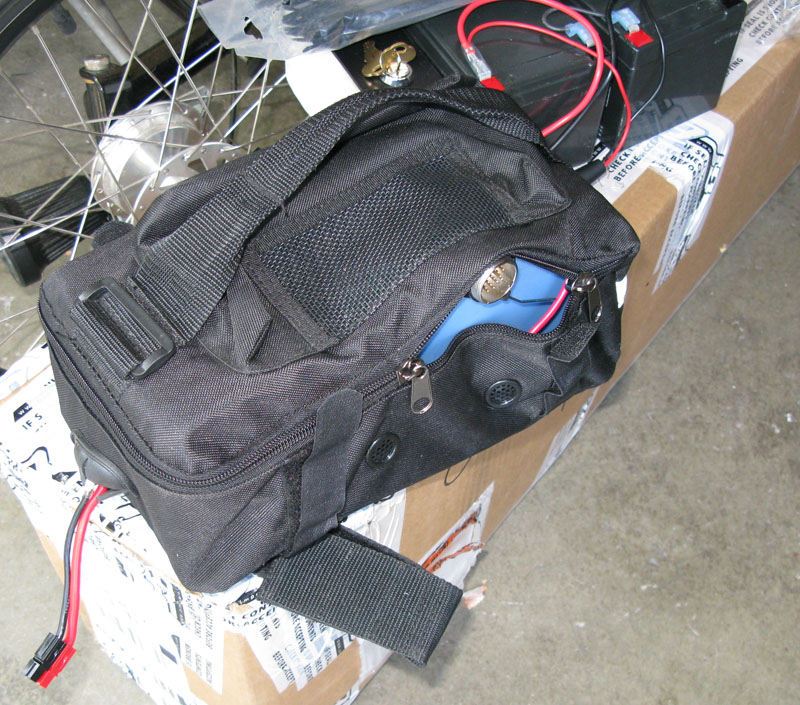
The pronged adapter peeking out of the saddlebag is the connector for charging the cells.
After every use, charge the battery. The memory-free battery does not require a full discharge before recharging. The battery lasts longer when stored fully charged.
Stored batteries will slowly discharge. If stored unused, top it off with a fresh charge every 30 days.
Avoid discharging the battery completely. If you notice a marked reduction in speed stop using your motor. Recharge as soon as possible.
Batteries are 100% recyclable. The local waste management office or battery distributor can advise on legal and safe battery disposal.
Throttle
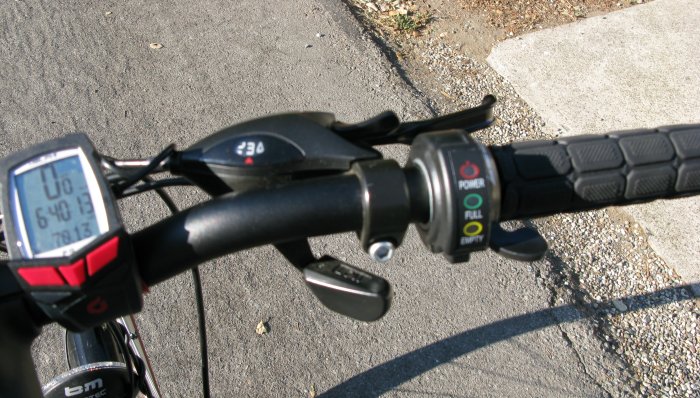
The throttle is the thumb paddle on the right grip
The throttle has indicator lights for "on" (power), "full" and "empty". I don't see how that last one can ever be illuminated. If the battery is empty, it can't power the bulb.
Battery Charger
You need a special charger for the battery pack. It monitors each of the cells, and charges them intelligently. A lot of people mount the charger on the bike, so you always have the charger with the battery. My commuting trips are more predictable, and I chose leave the charger at home.
It takes several hours to recharge the battery pack. All the lights come on when you start the charge. They gradually go off as individual cells are filled. All the lights should be off when charging is complete (5-8 hours or overnight).
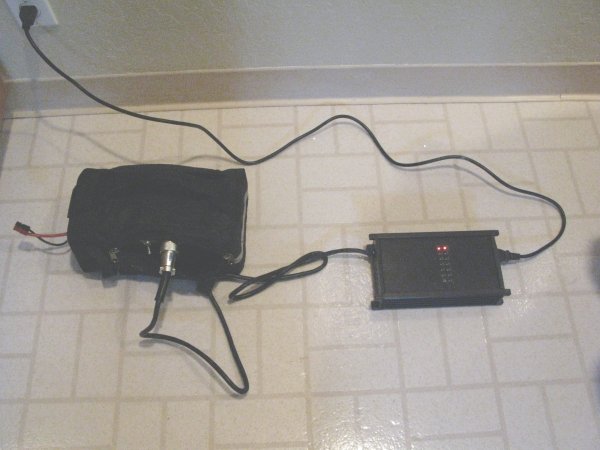
Battery pack on the left, charger on the right.
Warning: the charger draws power from the batteries, if left connected to the battery but not connected to the wall power outlet. This will discharge the battery in just a few days. Disconnect the charger from the wall and the battery after a charging cycle. Pull the charger cord from the wall socket first.
Static Test
All the components come with wiring which connects to the other components. Everything plugs into the controller - throttle, battery, motor. The surplus wiring is coiled, and concealed under velcro-wrap on the down tube (above the dynamo in the picture).
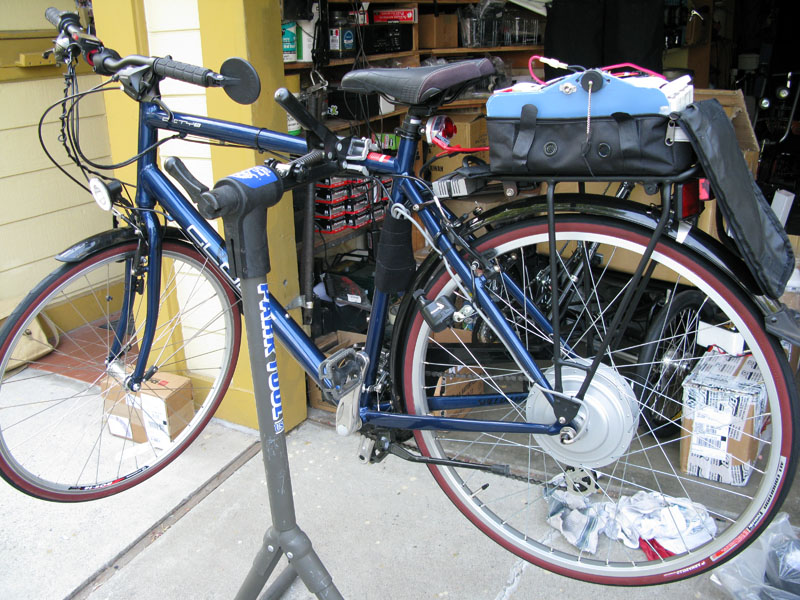
Here's how the project looks at this point. The light blue plastic in the saddle bag was cut from a rubbermaid box. It is to provide a solid surface to mount the charger connector on. The charger connector is covered by an item that looks like a sink plug.
Visible to the left of the charger connector is an on/off switch. The controller consumes a small amount of power, even when it is not doing anything, so you want a way to turn everything off.
We are ready for a static test.
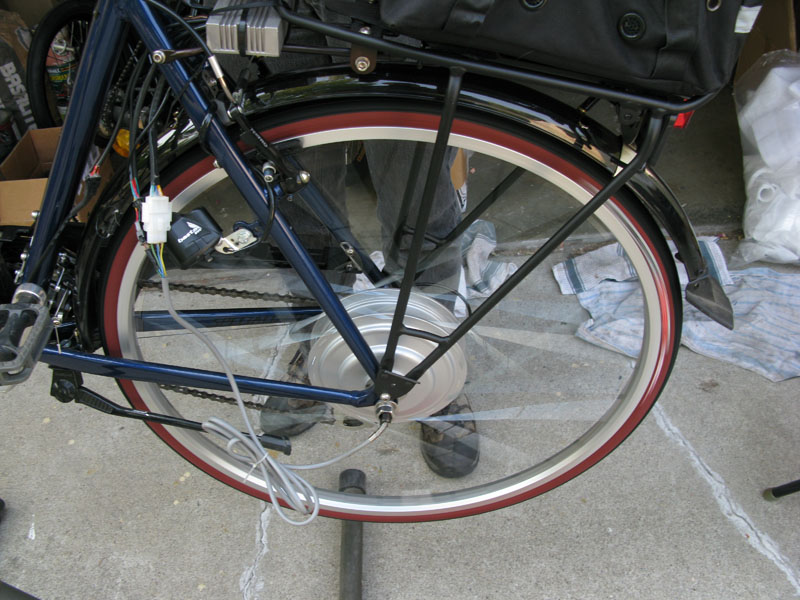
The static test is a rolling success!
Road Test
The final part is a road test. I made a short trip of a few hundred yards, without problems. The next day, I rode into work successfully, and have been commuting ever since.I really like the "stealth" appearance of this bike. Because the Li-ion battery is so small, the only clue that it is electric-powered is the fat rear wheel hub. I really like coming up behind fit young bicycle nuts on pricey mounts, and blowing past them at speed. Yes, indeed, that trick never gets old!
A Few Numbers
- The total cost of this project was $2100, including the original cost of the bike. At 58.5 cents/mile (IRS deduction rate in July 2008), you come out ahead if you go more than 3,600 miles on your bike. That's less than one year of commuting for me. Plus, you get the health and environment benefits.
- I built this bike in July 2008, and it took me about 10 hours of planning and research, and 4 hours build time.
- It's a 250 Watt motor, with a 10 amp-hour, 37 volt battery
Watts = amps * volts, so I've got 10 * 37 = 370 Watt/hours of energy on the bike.
The motor is rated at 250 watts.
So this battery can drive this motor for 370/250 hrs, just less than 90 minutes.
Update: from road tests, the range is 20-21 miles, with pedalling in normal traffic (stops and starts). The controller displays "full" right up until it cuts the juice and displays "empty". Not a very helpful indicator light.
For more range, pedal more and do fewer stop/starts. - The bike weighs 53 lbs total, and I usually pedal the first few miles without the motor at all. The motor weighs 9 lbs, the battery weighs 13 lbs, and the bike weighed 31 lbs before conversion.
-
US Federal law says that electrically-powered bicycles and
tricycles with less than 750 watts motors, limited to 20
MPH, and with functioning pedals are counted as ordinary
bicycles.
See Title
15, chapter 47, section 2085, paragraph b.
The controller limits my top engine speed to 342 rpm, which is 20 mph. This is a bicycle for the purposes of traffic law.
The Future
- The side stand that came with the bike, gave up after 2 days (because of the added weight). I replaced it with a V-legged center stand.
- I plan to rework the charging connector, so it sticks out of one end of the saddlebag, not the top.
- I am evaluating ways to secure the battery to the bike, so I don't have to carry it with me when I leave the bike.
- The bike needs to be locked up whenever it is not in use. There's a lot of bike theft in Santa Clara county, by people with bolt cutters and pick-up trucks. My friend Charlie had his bike stolen when he left it for 30 secs. He actually saw the pickup driving away into the distance.
- You can tip the odds in your favor by "differential locking" - use two different types of lock, like a chain and a new style kryptonite lock. Thieves tend to specialize in one type of lock, and not carry the tools to defeat two systems. More about bike locks. Don't leave your bike in secluded areas, like parking garages.
- I haven't yet needed a bell, but if I do, I'll get a compressed air horn. If you're fast, you should also be loud.
- There's a certain amount of jarring from the road, going to the handle bars, and thence my wrists. I cured it with fatter grips, but am considering suspension for the next bike.
References
1. www.werelectrified.com.
2. http://www.ebikes.ca/ (enthusiasts and components supplier).
4. electric recumbent lightweight!
5. the RC cells used on that recumbent
6. local Bay Area battery supplier
Let us end with a quote from my friends at nycewheels.com
-
Q: Are electric bikes awesome?
A: Totally awesome. Some would even say righteous.